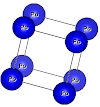M.A. Blanco ∗, E. Francisco, V. Luaña
Departamento de Química Física y Analítica, Facultad de Química, Universidad de Oviedo, 33006 Oviedo, Spain
Received 11 July 2003
Abstract:
Given the energy of a solid (E) as a function of the molecular volume (V ), the gibbs program uses a quasi-harmonic Debye
model to generate the Debye temperature Θ(V ), obtains the non-equilibrium Gibbs function G (V ;p, T ), and minimizes G
to derive the thermal equation of state (EOS) V (p, T ) and the chemical potential G(p, T ) of the corresponding phase. Other
macroscopic properties are also derived as a function of p and T from standard thermodynamic relations. The program focuses
in obtaining as much thermodynamical information as possible from a minimum set of (E, V ) data, making it suitable to analyse
the output of costly electronic structure calculations, adding thermal effects at a low computational cost. Any of three analytical
EOS widely used in the literature can be fitted to the p − V (p, T ) data, giving an alternative set of isothermal bulk moduli and
their pressure derivatives that can be fed to the Debye model machinery.
Program summary
Title of the program: gibbs
Catalogue number: ADSY
Program summary
URL: http://cpc.cs.qub.ac.uk/summaries/ADSY
Program obtainable from: CPC Program Library, Queen’s University of Belfast, N. Ireland
Licensing provisions: Persons requesting the program must sign the standard CPC non-profit use license
Computers on which the program has been tested: Intel Pentium, Alpha, Sun Sparc/Ultra/Blade
Operating system under which the program has been tested: Unix, GNU/Linux
Programming language used: Fortran 77
Memory required to execute with typical data: 700 KB
No. of bits in a word: 32
No. of processors used: 1
No. of bytes in distributed program, including test data, etc.: 277 497
No. of lines in distributed program, including test data, etc.: 7390
Distribution format: tar gzip file
Keywords: Quasi-harmonic Debye model, equation of state
To download the article click on the link below:









1 Comments
how to install (the commands) this program
ReplyDelete